Having a short list of must-see attractions in Iran is a hard task. Actually, Iran homes to several historical and natural attractions. So you need to have detailed itineraries or spend a reasonable time in order to visit all the landmarks.
Here we provide you top attractions of Iran so you can plan your trip not to miss these places while visiting Iran. You can find ancient destinations and natural attractions on this list!
Must-see Attractions of Iran
Persepolis
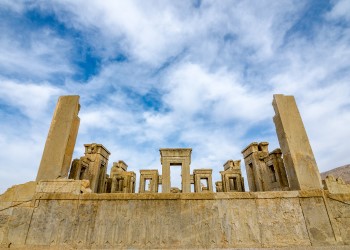
The name of Persepolis is associated with Iran! So put this magnificent historical site on your buck list. Persepolis is built during the Achaemenid era (522-486 BCE). It is a UNESCO historical site located near Shiraz.
The magnificent ruins of the Persepolis are the symbol of urban planning, construction technology, and art of Iranians. Besides, it was the seat of the government of the Achaemenid Empire.
Darius I in 518 BCE established Persepolis as the capital of the Achaemenid Empire. Mesopotamian architecture inspired the building. So it is a place on an immense half-artificial, half-natural terrace, the magnificent palace.
Going to Persepolis, climb to Artaxerxes II’s tomb to have a great view of magnificent Persepolis!
Gate of All Nations
Do not forget to visit the Gate of All Nations, you can see the stone bearded guards standing at each side of the place! The reliefs on the eastern staircase of the Apadana, or audience palace, is another thing that you should not miss at Persepolis. The reliefs depict the representatives from subject governments who bring gifts for the king.
Persepolis, a 13-ha area, has approaches, monumental stairways, throne rooms (known as Apadana), reception rooms, and other facilities. It is one of the biggest archeological areas in the world.
In the southwestern corner of the site, you can find private palaces during the reigns of Darius and Xerxes like Tachara and Hadish. The Palace of 100 Columns is another place that you should visit. A total of 100 stone columns support this 70 sq meters extravagant hall.
Last but not the least, do not forget to visit Persepolis Museum, which homes to several artifacts excavated at the site.
Read more: Shiraz Travel Guide: Things to Do in Shiraz
Naqsh-e Jahan Square

Isfahan houses to most brilliant landmarks of Iran. Naqsh-e Jahan Square is one of the must-see attractions of Iran. Also known as Imam Square, Naqsh-e Jahan is located in the heart of Isfahan.
It was once a part of the palace of Shah Abbas (1571 – 1629). Besides, the square is now home to several architectural wonders of Iran. Naqshe-Jahan means ‘pattern of world’ in Persian.
The two-story buildings surround the square, which was once a place for trading. With 512m long and 163m wide, it is one of the largest squares in the world and is a UNESCO World Heritage site. With fountains and gardens in the middle, the square embraces gems of Safavid architecture. They are Shah Mosque, Sheikh Lotfollah Mosque, Ali Qapu, and Qeysarieh portal.
The whole square is pedestrian and some horse-drawn carriages and a few electric carts are available for visitors. Don’t miss the bazaar of Isfahan and souvenir shops at the place. Do not miss other attractions:
Shah Mosque
Known also as Imam Mosque, the construction was completed in 1629. It is a UNESCO world heritage site and is a great manifestation of Islamic architecture. The place mesmerizes you with Intricate blue-tiled mosaics, and glittering iwans. There ar also towering minarets, and calligraphy works on the walls. The construction contains 18 million bricks and 475,000 tiles and employed the new haft rangi (seven-color) style of tile mosaic.
Ali Qapu
Dominate one side of beautiful Naqsh-e Jahan, Ali Qapu is a six-story edifice 38 m high. Shah Abbas, I built the palace in the late 16th century as a gate to his residence.
Ali Qapu boasts an elevated terrace with 18 columns. However, the gem of the edifice is the music room on the upper floor. The room fascinates you with the stucco ceiling. It is stenciled with the shapes of vases and rose-water shakers. It was a place for private ceremonies and some concerts.
Sheikh Lotfollah Mosque
This unique mosque is known for its golden-creamy tile work and complex arabesques. The color of the tiles turns pink from sunrise to sunset. The interesting point about this mosque is that it does not have any minarets. That is because it was for the royal family and not for public use.
The mihrab of the mosque with its unusual high niche is one of the finest in Iran. The mosque is named after the ruler’s father-in-law, Sheikh Lotfollah. He was a revered Lebanese Islamic scholar who curated Shah Mosque and Isfahan theological school in the early 17th century.
Read also: Some Best Isfahan Hotels in 2020
Historic City of Yazd
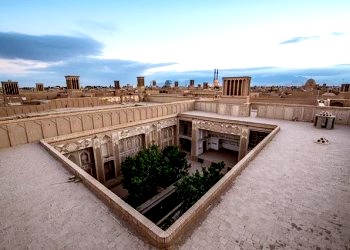
Traveling to Yazd, you can embrace the beauty of desert architecture. The Historic City of Yazd is one of the top attractions of Iran.
At Yazd, the walls, roofs, domes, and other parts of buildings are built from the earth!
This Yazd attraction is the manifestation of an eco-friendly manner. They adjust to the desert climate and environment.
You can find several alleys at Yazd old town in their original shapes. Each neighborhood has a water cistern (Abanbar), bathhouses, and a mosque. You can walk in Sabats, covered alleys, which are built to protect you from the sun.
The skyline of the city is a spectacle featuring wildcatters, minerals, and domes. The Historic City of Yazd was on the UNESCO heritage list in 2017.
In the old city, you can also pay a visit to the Jame Mosque, which is originally built on a Fire Temple. However, today building is constructed in the 19th century. The tiled entrance of the mosque and 52-meter minarets are one of the highest in Iran.
The minarets are adorned with 15th-century inspirations and the mosque is in the Azari style of Persian architecture. The glittering blue tiles adorn the portal facades.
Read also: Traditional Villages of Iran, An Exotic Experience
Nasir Al Molk Mosque, Shiraz
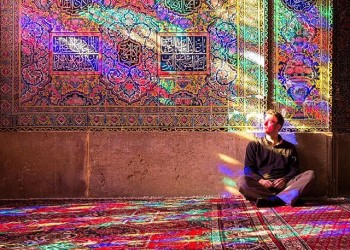
Shiraz is the city of poetry and beauty. You can find several historical places in this city. However, Nasir Al Molk Mosque is one of the must-see attractions of Iran.
Known also as the pink mosque, Nasir Al-Molk Mosque is a rare example of Islamic architecture with its unique vibrant colors. The stained glasses and colorful tiles make an eye-catching scene in the morning at the mosque.
Also known as the Pink Mosque, the Nasir al-Molk was constructed between 1876 and 1888 during the Qajar era.
It is interesting to know that the tiles with the rose-pink floral design are the signature of Shiraz art of tiling in Iran.
Another interesting point about Nasir Al-Molk is that the mosque has survived several earthquakes. The reason is using flexible woods within the walls of the structure as you can see the wooden bricks in the iwan columns.
The best time to visit the place is early morning before 11 A.M. when you can and enjoy the reflection of stained glasses under the sunlight on the floor. However, if you be at the place before 9 A.M. you can enjoy the tranquility of the place.
Read also: Amazing Local Experiences in Iran
Golestan Palace, Tehran
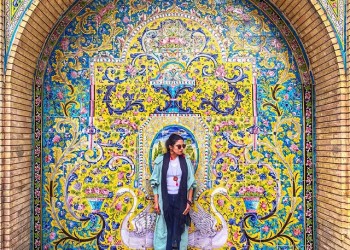
The capital of Iran, Tehran, is a vibrant city with historic buildings. You can spend several days in this beautiful city. Golestan Palace is a great place you should not miss while visiting Iran!
Finding a quiet glamourous and green space amid the crowd of Tehran downtown is really like a miracle. Golestan Palace is exactly that miracle that happens in the heart of Tehran! A place that fills you with tranquility, beauty, and wonder. You enter a garden with an abundance of trees, breath-taking edifices, and parrots flying over your head.
Nasser al-Din Shah (r 1848–96) built this palace over a citadel dated back to the Safavid era (1501-1722). Inspired by his trips to Europe, he wanted to build a European-like palace in Tehran. The original palace was bigger than what you visit today. Pahvalis (1925–1979) demolished several buildings. However, there are some parts of this palace that you should put on the must-see sites of Tehran.
Shamsolemareh
Located on the eastern side of the palace, Shamsolemareh is a 35-meter high building with five floors. It was once the symbol of Tehran and was the tallest building of the capital at that time. Besides, it was the first building in Tehran with metal in its construction.
Nasser al-Din Shah ordered the construction of this building after his European journeys. So it is a combination of Iranian and western architecture. He wanted to build an edifice on the roof which, he can have a panoramic view of Tehran.
The first floor is the king’s porch and it is decorated with mirroring and seven-color tiles, as a sign of the Qajar era. There is a clock on the top of the edifice which was a present from Queen Victoria of England (1819 –1901) to the court.
Read also: A Complete Guide to Travel Tehran
Qeshm Geopark
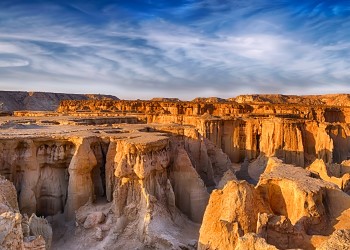
part of UNESCO as the Qeshm Island Geopark are most of the islands including canyons, hills, and valleys.
Qeshm Island has ecotourist attractions.
Herra mangrove forest of the island hosts 1.5% of the world’s birds each year.
The geosites of the Qeshm are Stars Valley, Nammakdan Salt Complex, Chahkooh, and Harra mangroves forest.
Laft village, Kharbas cave, Naz Islands, Qeshm Island UNESCO Geopark Museum, and turtle nesting beach are other parts of the geosites of the Qeshm Island that you should not miss while visiting the island.
Lut desert
Spending a night in the desert is one of the top attractions of Iran. Lut Desert is near Kerman, which is the largest city in southeast Iran.
In 40 km of Shahdad city, there is a legendary phenomenon; Kalout. From a distance, you see a series of structures, which resemble a big city amid the desert. However, when you reach the place, you encounter a series of rocks. They change their shape due to erosion. The best time to visit the Kalouts is during sunrise and sunset. In that time the sunshine plays a colorful game on these natural wonders.
Kalout is a part of Lut Desert and you can visit Rood-e Shoor (Salty River). It is the only river that flows in a desert all seasons during your visit to Shahdad.
A camp is located 20 km to Shahdad and provides you a facility to enjoy starry nights in the desert. You can also enjoy a safari, camel riding, and walking barefoot in the desert there.
Read also: Find Some Natural World Wonders in Iran
Badab e Soort
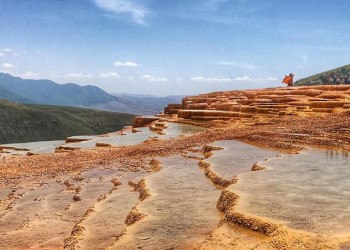
This wonderful stairway spring, Badab Soort, is a must-see in Iran. It is near Sari of Mazandaran Province in northern Iran. Badab Soort is the second saltwater spring in the world after Pamukkale spring in Turkey.
It has two springs one is very salty in 15-meter diameter. Its water is a treatment.
The other is red and orange because of iron oxide from the ground to the surface.
You can enjoy the beauty of layers in different colors and sizes. Pines, bushes in an interesting landscape surround This beautiful phenomenon.
Read also: Best Things to Do and Experience in Iran
Last but not least
Visiting the top attractions of Iran is one of the ways that you can visit the gist of Persian civilization and beauty in a limited time. These attractions are rare and unique in the world so don’t hesitate to put them on your bucket list!


2 Comments
How can I book a flight to Shiraz?
Hey Hui Yin, you can book your domestic flights here:
https://exotigo.com/flights